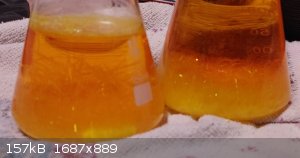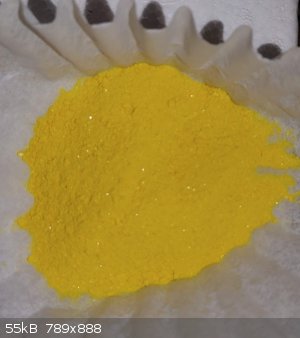night429
Harmless

Posts: 49
Registered: 12-11-2019
Member Is Offline
Mood: 
|
|
Accidentally making potassium picrate(?)
Yesterday, I tried to make some picric acid from a procedure that has been successful in the past, but I decided to use 100mL of sulfuric acid instead
of 140mL in an attempt to conserve it. I used 17.5g of salicylic acid and 43.1g of potassium nitrate as well. The reaction went uneventful (I kept the
temperature above 100°C), although I got it too hot at times and NO2 was produced. At the end, the temperature dropped, and a bunch of
what I believed to be picric acid crashed out. I added an additional 20mL of sulfuric acid, but it didn't dissolve anything. I considered this done,
even though I had a small amount of potassium nitrate left (less than a gram).
I crashed it out into around 300mL of ice and water, filtered, squeezed out the water, then recrystallized from water and let it cool. Everything was
going as expected, and some nice crystals started to form, too.
Crystals growing in flask:

Then, I put the solution in the freezer, because the flasks were only slightly warm. Upon checking them 20min later, I saw a that a dust of crystals
had "snowed" onto the bigger crystals. At this point, I knew something was off, but I cooled it further and filtered.
I knew right away by the color that whatever I made was not picric acid; it was a golden-yellow, and not a pale-yellow. I dried it to test its
properties, and its flame sensitivity in comparison to pure picric acid was evident (it melted, then burned very quickly with a hissing noise and a
lot of dark-gray smoke).
Dried product:

The reason for posting this is that I don't know exactly what caused it, and this happened to me before (over a year ago), but I didn't think much of
it until it happened again. I've never seen anyone report that they accidentally made it when they wanted to make just picric acid.
The only two things that I changed were the amount of sulfuric acid and the amount of ice water I crashed it into (I decreased it by about half to
limit how much picric acid dissolved). Is it possible that there wasn't enough acid? Or was it the decreased amount of water that caused a higher
concentration of potassium ions?
[Edited on 6-5-2021 by night429]
|
|
|
night429
Harmless

Posts: 49
Registered: 12-11-2019
Member Is Offline
Mood: 
|
|
Apologies to necropost, but I again isolated primarily potassium picrate instead of picric acid. This time, I used a different procedure.
I first heated 150mL of 87% sulfuric acid to 90°C and added 21.8g of salicylic acid, then cooled. Once it went below 45°C, I added 54.7g of
potassium nitrate, keeping the temperature below 45°C. Once added over the course of about 90 minutes, I heated to 120°C for 20 minutes. The
temperature went to about 130°C at the peak, and over the course of the 20 minutes, the color went from an orange to a yellow-ish.
I crashed everything out in about 400mL of ice-water, then filtered. I washed everything with a small amount of water, then let it sit for about a
day. I scooped this wet filtrate into a 500mL flask and tried to recrystallize it with sufficient water to top to the 500mL mark. There was still a
substantial amount left undissolved, even at boiling. I feared I had either made too much for the flask to handle, or the undissolved product was
potassium picrate, so I let it cool, chilled it, and filtered everything out.
The product I made was consistent with potassium picrate, burning with a sooty flame and a hissing noise. So, I'm wondering how this happened,
especially because I had made plain picric acid through this procedure before.
Is it because I didn't wash out enough potassium ions before the recryst? Is the amount of sulfuric acid too low that the picric acid forms a salt
with the potassium bisulfate? I have yet to see others fail in the way that I have, in making potassium picrate instead of picric acid using common
procedures. Please help me.
|
|
|
ManyInterests
National Hazard
   
Posts: 966
Registered: 19-5-2019
Member Is Offline
|
|
I made quite a bit of picric acid in the past (I'm the reason why picric acid is a sticky topic here) and sometimes I used a little too much nitrate
to insure that the reaction had all the nitrate it needed to work. I start with salicylic acid, too. I usually used sodium nitrate, but I have done it
with potassium nitrate as well. I prefer using sodium nitrate since I need less in volume for it, and the picrate formation is always big in my mind.
The amount of sodium nitrate I use is 2.3 to 2.5g per 1g of salcylic acid. when using potassium I adjust the amount based on molar mass. for sulfuric
acid, I use 4ml of 95-98% sulfuric acid for each gram of salicylic acid.
I use Rosco's (a banned user who was an authority on picric acid around here). Which involves heating up the dissolved acid solution to 115C to let it
turn turn into a reddish brown solution before letting it cool down to around 97C, and then while maintaining the temperature from 96 to 100C the
nitrate salt is added SLOWLY with strong stirring until it is all added, then allowing it to slowly heat up to 120C and kept there for 5 minutes (I
let it go up to 124C for 5 minutes, as it is slightly above the melting point of picric acid and it allows everything to fully nitrate).
I then let everything cool down and what happens after varies. letting it cool down to room temperature could result in the entire mass solidifying,
but adding water as it is around 65C will prevent it from solidifying, but it will foam and emit NO2 gasses, and it also affects yields I find. I
haven't crashed my picric acid in water in a long time. The problem with it solidifying is that getting the chunk to break back up is a bitch to say
the least, but adding water to it at that time doesn't cause the adverse reactions as it does when it is hot for some reason. Maybe I need ot try
again. But there is always the fear that i might break my beaker, which would be a disaster...
However I find it very strange that a picrate salt would form. Potassium nitrate is a neutral salt. It is neither acidic nor is it basic. Isn't
picrate formation generally a thing when the picric acid reacts with a base? Hydroxides or bicarbonates/carbonates are usually the go-to (you can make
ammonium picrate using either ammonia solution OR ammonium carbonate).
Also the way you described its behavior as having burning with a hissing and sooty burn is actually more characteristic of picric acid than picrate,
which burns much quicker and more explosively. The soot comes from the fact that picric acid, like many secondaries, is fairly oxygen poor.
And potassium picrate is soluble in water. With that amount of water you mentioned it should have been fully dissolved. If it isn't dissolving with
that much hot water, then I highly doubt it is picrate
https://chemister.ru/Databases/Chemdatabase/properties-en.ph...
This shows that potassium picrate's solublity in water is 25g in 100ml at 100C. You used a total of 21.8g of salicylic acid to start. Even with a
stiochiometric theortical maximum yield, there would be no way you would have yielded enough of anything for it NOT to dissolve in a few hundred mls
of boiling hot water.
|
|
|
|